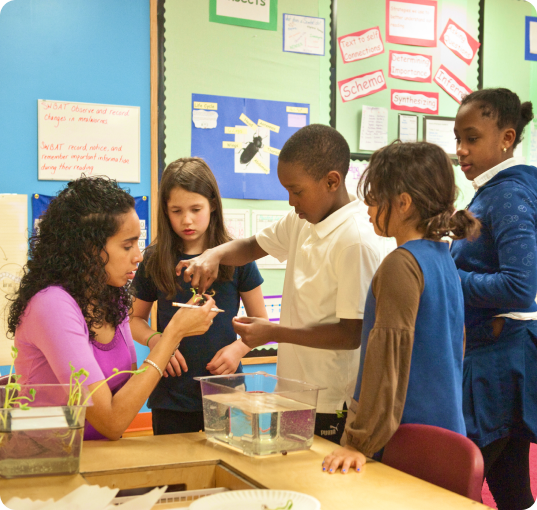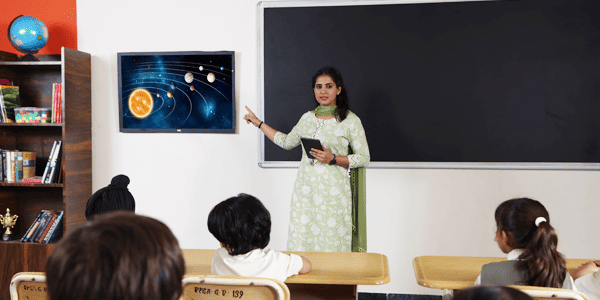Find the Best Primary Science Tuition Singapore for Enhanced Learning
Find the Best Primary Science Tuition Singapore for Enhanced Learning
Blog Article
A Comprehensive Overview to the Numerous Understanding Approaches in Key Scientific Research Direction
The exploration of diverse learning approaches in main science instruction offers a possibility for teachers to improve student involvement and understanding substantially. By taking a look at hands-on discovering techniques, inquiry-based approaches, and joint methods, we can determine effective techniques that deal with different learning designs. Furthermore, the combination of innovation and differentiated guideline plays an important role in cultivating a comprehensive atmosphere. The concern stays: how can these techniques be effectively applied in the classroom to maximize their effect? The response exists in a closer analysis of each method and its implications for mentor scientific research.

Hands-On Discovering Strategies
Hands-on understanding techniques play an essential role in main scientific research instruction, involving students in energetic exploration and testing. These methods enable students to communicate straight with sensations and materials, cultivating a deeper understanding of scientific principles. By using manipulatives, versions, and real-life experiments, educators produce an atmosphere where students can observe, hypothesize, and evaluate their ideas.
Such methods not only improve understanding yet also grow important thinking and analytical abilities. When pupils join activities like constructing straightforward devices, growing seeds, or conducting chemical responses, they are urged to ask concerns and seek answers with their own observations. This experiential method aids to debunk complicated scientific concepts, making them much more relatable and obtainable.
Additionally, hands-on discovering promotes collaboration among peers, as trainees often operate in teams to conduct experiments or share searchings for. This team effort not only enriches their knowing experience but likewise develops important social abilities. Eventually, integrating hands-on methods in main science direction fosters a lifelong love of learning and inquisitiveness about the natural world, laying a strong foundation for future scholastic quests in scientific research and beyond.
Inquiry-Based Discovering
Inquiry-based understanding is a training technique that encourages pupils to ask inquiries, check out phenomena, and build their own understanding of scientific ideas. This approach moves the focus from typical teacher-led instruction to a much more student-centered experience, where students take the effort in their academic trip. By promoting curiosity, inquiry-based understanding promotes much deeper involvement with the material, enabling students to discover subjects in a significant context.
In technique, this method usually includes hands-on experiments, observations, and essential thinking activities that line up very closely with the clinical approach. Pupils are motivated to create hypotheses, style examinations, and analyze information, which grows vital abilities such as analytical and problem-solving reasoning. The role of the instructor in this structure is to help with exploration, assisting trainees via the inquiry process while urging independent idea and collaboration.
Additionally, inquiry-based knowing nurtures a sense of possession over the learning procedure, motivating trainees to pursue understanding actively. This method not only boosts understanding of scientific principles however also cultivates a long-lasting love for learning, equipping trainees with the skills necessary to browse a significantly intricate world.
Collaborative Discovering Approaches
Collective discovering techniques equip trainees to involve in meaningful interactions with peers, promoting a shared obligation for their academic results. In key scientific research direction, these techniques motivate learners to collaborate to explore clinical principles, fix troubles, visit this site right here and carry out experiments (primary science tuition Singapore). By taking part in team activities, trainees can leverage varied point of views, permitting richer understanding and retention of clinical knowledge
One trick element of joint knowing is the focus on communication abilities. Trainees should verbalize their thoughts, pay attention actively to others, and bargain concepts, all of which are essential expertises in both real-world and scholastic contexts. This social interaction not only enhances their understanding of scientific principles yet additionally promotes teamwork and conflict resolution skills.
When pupils see the value of their payments within a team, they are more most likely to take ownership of their discovering journey. Generally, including joint knowing techniques in primary science direction cultivates a vibrant knowing atmosphere that prepares students for future academic and social obstacles.
Technology Assimilation in Scientific Research
The combination of technology in main scientific research guideline boosts learning experiences by supplying cutting-edge tools and resources that support numerous mentor methodologies, including collective knowing - primary science tuition Singapore. The use of electronic platforms, simulations, and interactive applications allows trainees to involve deeply with scientific ideas, assisting in a much more hands-on strategy to discovering
Virtual laboratories, for instance, make it possible for students to carry out experiments securely and efficiently, promoting inquiry-based understanding. These tools can replicate real-world clinical scenarios, enabling trainees to imagine intricate procedures that would be tough to duplicate in a conventional classroom setting. In addition, technology fosters communication and cooperation among pupils, as they can share searchings for and interact on projects through on the internet systems.
Furthermore, multimedia discussions and educational videos can enhance lessons by satisfying varied discovering designs, making abstract concepts extra accessible. Information analysis devices likewise equip trainees to gather and analyze scientific information, enhancing important assuming skills. Generally, the strategic consolidation of technology in main science guideline not only improves interaction however likewise prepares trainees for a highly advanced society, furnishing them with necessary skills for future clinical endeavors.
Distinguished Direction Techniques
Differentiated guideline strategies are important for attending to the varied needs of learners in key scientific research education and learning. These approaches allow instructors to customize their teaching methods to suit differing abilities, passions, and finding out styles within the class. By utilizing distinguished direction, teachers can produce a comprehensive environment that fosters interaction and top article improves understanding of clinical principles.
One reliable strategy is to use flexible grouping, which allows students to collaborate with peers at similar skill levels or with differing viewpoints. This approach urges peer knowing and promotes important reasoning. In addition, supplying selections in assignments can empower students, allowing them to choose jobs that reverberate with their passions while still fulfilling curricular purposes.
Moreover, incorporating tiered projects is one more useful method. By making jobs with differing levels of complexity, teachers can make certain that all students are properly challenged, no matter their proficiency. Utilizing formative analyses to gauge understanding more allows teachers to adjust their educational approaches dynamically, ensuring that each student obtains the support they require.
Inevitably, carrying out set apart direction strategies in key scientific research education and learning not only boosts pupil knowing outcomes yet also grows a passion for scientific research, preparing students for future scholastic quests.

Final Thought
In Recommended Site summary, efficient primary science instruction necessitates a diverse method that encompasses hands-on learning, inquiry-based methods, and collaborative strategies. The assimilation of modern technology and differentiated direction further provides to varied learning designs, promoting an atmosphere conducive to exploration and essential reasoning.
The exploration of diverse learning methods in main scientific research guideline offers an opportunity for teachers to boost pupil interaction and comprehension substantially.Hands-on understanding strategies play a pivotal duty in primary scientific research guideline, involving trainees in active exploration and experimentation.Inquiry-based understanding is an educational technique that motivates students to ask inquiries, check out phenomena, and construct their very own understanding of scientific concepts.Joint understanding techniques empower pupils to involve in meaningful interactions with peers, cultivating a common responsibility for their educational end results. In general, incorporating collective knowing strategies in main science guideline cultivates a dynamic learning setting that prepares trainees for future academic and social challenges.
Report this page